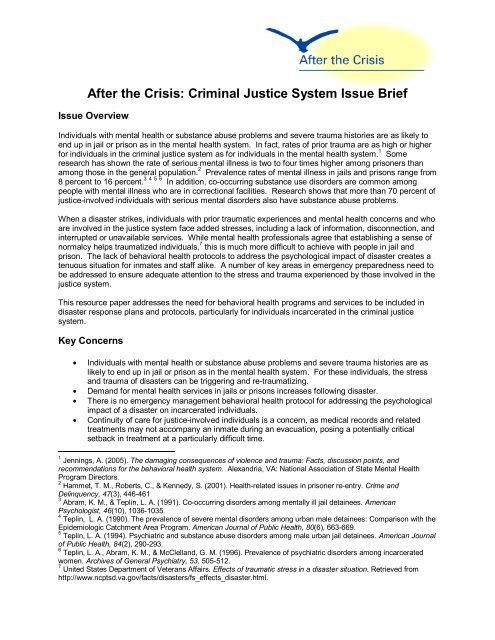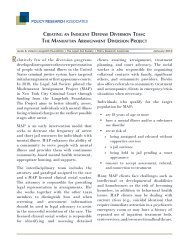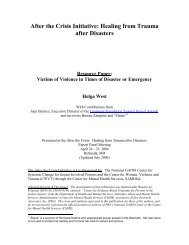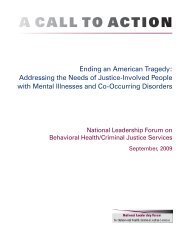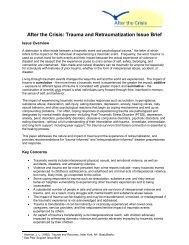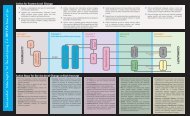Criminal Justice System Issue Brief - SAMHSA'S GAINS Center for ...
Criminal Justice System Issue Brief - SAMHSA'S GAINS Center for ...
Criminal Justice System Issue Brief - SAMHSA'S GAINS Center for ...
Create successful ePaper yourself
Turn your PDF publications into a flip-book with our unique Google optimized e-Paper software.
After the Crisis: <strong>Criminal</strong> <strong>Justice</strong> <strong>System</strong> <strong>Issue</strong> <strong>Brief</strong><strong>Issue</strong> OverviewIndividuals with mental health or substance abuse problems and severe trauma histories are as likely toend up in jail or prison as in the mental health system. In fact, rates of prior trauma are as high or higher<strong>for</strong> individuals in the criminal justice system as <strong>for</strong> individuals in the mental health system. 1 Someresearch has shown the rate of serious mental illness is two to four times higher among prisoners thanamong those in the general population. 2 Prevalence rates of mental illness in jails and prisons range from8 percent to 16 percent. 3 4 5 6 In addition, co-occurring substance use disorders are common amongpeople with mental illness who are in correctional facilities. Research shows that more than 70 percent ofjustice-involved individuals with serious mental disorders also have substance abuse problems.When a disaster strikes, individuals with prior traumatic experiences and mental health concerns and whoare involved in the justice system face added stresses, including a lack of in<strong>for</strong>mation, disconnection, andinterrupted or unavailable services. While mental health professionals agree that establishing a sense ofnormalcy helps traumatized individuals, 7 this is much more difficult to achieve with people in jail andprison. The lack of behavioral health protocols to address the psychological impact of disaster creates atenuous situation <strong>for</strong> inmates and staff alike. A number of key areas in emergency preparedness need tobe addressed to ensure adequate attention to the stress and trauma experienced by those involved in thejustice system.This resource paper addresses the need <strong>for</strong> behavioral health programs and services to be included indisaster response plans and protocols, particularly <strong>for</strong> individuals incarcerated in the criminal justicesystem.Key Concerns• Individuals with mental health or substance abuse problems and severe trauma histories are aslikely to end up in jail or prison as in the mental health system. For these individuals, the stressand trauma of disasters can be triggering and re-traumatizing.• Demand <strong>for</strong> mental health services in jails or prisons increases following disaster.• There is no emergency management behavioral health protocol <strong>for</strong> addressing the psychologicalimpact of a disaster on incarcerated individuals.• Continuity of care <strong>for</strong> justice-involved individuals is a concern, as medical records and relatedtreatments may not accompany an inmate during an evacuation, posing a potentially criticalsetback in treatment at a particularly difficult time.1 Jennings, A. (2005). The damaging consequences of violence and trauma: Facts, discussion points, andrecommendations <strong>for</strong> the behavioral health system. Alexandria, VA: National Association of State Mental HealthProgram Directors.2 Hammet, T. M., Roberts, C., & Kennedy, S. (2001). Health-related issues in prisoner re-entry. Crime andDelinquency, 47(3), 446-4613 Abram, K. M., & Teplin, L. A. (1991). Co-occurring disorders among mentally ill jail detainees. AmericanPsychologist, 46(10), 1036-1035.4 Teplin, L. A. (1990). The prevalence of severe mental disorders among urban male detainees: Comparison with theEpidemiologic Catchment Area Program. American Journal of Public Health, 80(6), 663-669.5 Teplin, L. A. (1994). Psychiatric and substance abuse disorders among male urban jail detainees. American Journalof Public Health, 84(2), 290-293.6 Teplin, L. A., Abram, K. M., & McClelland, G. M. (1996). Prevalence of psychiatric disorders among incarceratedwomen. Archives of General Psychiatry, 53, 505-512.7 United States Department of Veterans Affairs. Effects of traumatic stress in a disaster situation. Retrieved fromhttp://www.ncptsd.va.gov/facts/disasters/fs_effects_disaster.html.
• Incarcerated individuals are disconnected from the outside world and may not have access toin<strong>for</strong>mation about the disaster at hand and how the situation is affecting their loved ones outsidethe jail or prison. Inmates may also be displaced and disconnected from family members duringand after disasters.• Responders work long hours and this puts added strain on staff and families. This stress mayadversely affect staff treatment of justice-involved people.• In communities taking in large numbers of evacuees, demands on criminal justice systems alsoincrease.• In New Orleans following Hurricane Katrina, there was a breakdown in the criminal justice systemthat had not been previously anticipated.Potential Solutions and Recommendations• Create responder family assistance centers to help individuals manage stress.• Involve peer representatives on emergency management planning teams <strong>for</strong> the criminal justicesystem.• Encourage states to include a detailed criminal justice annex in their state emergencymanagement plans that can be tailored and replicated by local jurisdictions.• Identify resources to assist justice-involved individuals.• Assist inmate evacuees in connecting with family or other supporters.• Establish a clear evacuation protocol <strong>for</strong> prisoners.• Advocate <strong>for</strong> establishment or continuity of benefits and care.• Develop protocols to govern re-entry from prison.• Provide peer-run training <strong>for</strong> criminal justice professionals, and raise awareness of the behavioralhealth needs of justice-involved people and related emergency protocols.• Establish a means <strong>for</strong> registered sex offenders and parolees to easily register their locations.• Develop a task <strong>for</strong>ce to interview and observe how the New Orleans criminal justice system andinmate population is recovering, and collect data <strong>for</strong> use in improving emergency preparednessprotocols and procedures.Key ResourcesA Guide to Preparing <strong>for</strong> and Responding to Prison Emergencies, Schwartz, J.A., Barry, C., U.S.Department of <strong>Justice</strong>, National Institute of Corrections NIC#020293 (June 2005)American Correctional AssociationAmerican Correctional Health Services AssociationAssociation of State Correctional AdministratorsCorrectional Education AssociationNational Institute of CorrectionsWe wish to thank Angela McCown, author of <strong>Criminal</strong> <strong>Justice</strong> <strong>System</strong>s <strong>Issue</strong>s and Response in Times ofDisaster, on which this issue brief was based.The After the Crisis Initiative is Co-Sponsored by: The National <strong>GAINS</strong> <strong>Center</strong> <strong>for</strong> <strong>System</strong>ic Change<strong>for</strong> <strong>Justice</strong>-Involved Persons and the <strong>Center</strong> <strong>for</strong> Women, Violence and Trauma (CWVT) through the<strong>Center</strong> <strong>for</strong> Mental Health Services, SAMHSA.Acknowledgement & Disclaimer: The development of this publication was funded under Request <strong>for</strong>Proposal (RFP) No.280-04-0106, entitled: “<strong>Center</strong> <strong>for</strong> Evidence Based Programs <strong>for</strong> Persons in the<strong>Justice</strong> <strong>System</strong>” from the Department of Health and Human Services, Substance Abuse and MentalHealth Services Administration’s <strong>Center</strong> <strong>for</strong> Mental Health Services (CMHS), awarded to Policy ResearchAssociates, Inc. (PRA). The views and opinions expressed in this publication are those of the authors,and do not necessarily represent the official position or policies of PRA’s National <strong>GAINS</strong> <strong>Center</strong> or the<strong>Center</strong> <strong>for</strong> Mental Health Services (CMHS).


